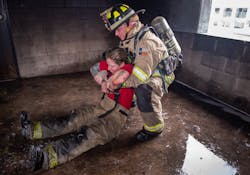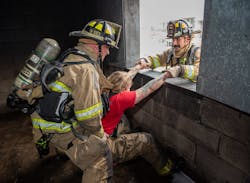In my September 2022 column, “Search With a Purpose,” the fire that served to provide context to the discussion spurred some great ladder rescue conversation. Rescues over ladders are something that we must prepare for because they fall into the high-risk/low-frequency category of the trade.
I don’t focus solely on VES (vent enter search) or VEIS (vent enter isolate search) in this piece, although that tactic goes hand in hand with rescues over ladders. In fact, most might assume that the matter of rescues over ladders results from VES. However, there are several occasions when a ladder rescue is your best/only option for a successful rescue.
Credit for the statistics that I cite in this piece belongs to Firefighter Rescue Survey (firefighterrescuesurvey.com), in particular the section that covers the first 2,000 rescues that were reported. The crew at the FRS Project does amazing work for the fire service, and I encourage you to submit the statistics for all of the rescues that your department performs.
Victim size
Before you can bring victims down a ladder, you must get them to the window. When you size up a structure, determining search priorities and tactics must consider the four factors that are described below.
First, it is absolutely vital that you take into consideration the size of the victim. Of course, this is an obvious unknown for firefighters.
You might be fortunate enough to have someone available on scene (a resident/neighbor) who can let you know what you might be dealing with. However, there are obvious issues here. If you’ve been in the service for any length of time, you know that “helpful” citizens aren’t always the most reliable. The “baby” who is trapped inside could be a young child, a full-size adult or an animal of some sort. In other words, “baby” is a relative term.
Typical fire victims’ size won’t be known until you have hands on them, which makes the removal decision more difficult.Fire conditions and staffing
Fire conditions is the second and, arguably, the most important factor that you must consider when sizing up victim removal. The common saying “conditions dictate tactics” holds true in these cases.
If you have time to effect a nice, smooth rescue, you are fortunate. Most times, the fire doesn’t allow that kind of time for your victim, and you must make your move quickly, with limited knowledge of an egress other than the way that you go in.
Another major factor is staffing. This is a struggle for most of the fire service. Do you have the staffing on scene to help? If so, perfect: Make the plan and get them out.
However, your mission, no matter your staffing, is to get victims out of the immediately dangerous to life and health (IDLH) environment. To quote Driver/Engineer Otis Schmidt from “Backdraft,” “John Wayne time!” You have your work cut out for you. Rely on your training and accomplish the mission.
Egress with the victim
The fourth factor is distance to the nearest exit for the victim. When you enter the structure via a ladder, another egress might not be obvious. Conversely, when you enter through the door and need to exit out of a window, you might not know what windows have a ladder in place. Does your department have a standard operating procedure or a standard operating guideline that dictates a ladder to every upper-level window? Is that even feasible, considering victims usually are brought out early in the scene?
A good 360 size-up prior to entry or communication on scene can help to guide you to the best point of egress.
You shouldn’t get into the habit of always pulling victims out of the entrance of the structure where you entered. Instead, you should head to the closest exit, for victims’ well-being.Lifting technique
In 82 percent of the first 2,000 rescues that were performed and reported since the inception of the Firefighter Rescue Survey, the dirty drag technique was used to remove the victim. A dirty drag is when firefighters remove the victim by dragging them without using webbing or tools.
Webbing drags were used in 3 percent of those 2,000 rescues.
In those 2,000 rescues, victims were removed from the structure via ground ladder 14 percent of the time, and an aerial ladder was used for victim 1 percent of the time. Of the rescues via a ground ladder, the victim was found on the second floor 30 percent of the time, on the third floor 7 percent of the time and on a floor higher than the third floor 2 percent of the time.
In some cases, it might be faster to remove a victim out of a window rather than dragging the individual to a doorway to exit.
Lifting an unconscious, burned victim up and out of a window can be an extremely physically demanding task. (Author’s note: Performing a window cutdown can be a great option.) However, depending on the size of the victim and the strength of the firefighter, lifting the victim out of the window might not be difficult.
There are two specific techniques for lifting large victims out of a window based on the position in which the victim is found: head toward the window or feet toward the window. Firefighters must be proficient with these techniques for removing victims down ground ladders.
When removing victims down a ground ladder, whenever possible, the members of outside ladder crews should be proactive and place a second ladder next to the initial ladder. This strategy allows a second rescuer to help the initial rescuer to manage the victim’s weight.
The rescuer on the ladder places one arm between the victim’s legs and the other arm under the victim’s armpit. Both of the rescuer’s hands should grasp the beams of the ladder, which allows both hands to slide down as the rescuer descends with the victim.
Communication between the inside rescuer and the rescuer who is on the ladder is critical. The inside rescuer must ensure that the outside rescuer has a firm grasp on the victim prior to letting go of the individual.
When the victim initially is found, it’s important for rescuers to notify the incident commander (IC) of where they will bring out the victim from the building. This allows the IC to direct EMS to that location.
Ladder lengths
Having ladders that are of differing lengths isn’t an issue, although it’s ideal when the angle of both ladders is the same.
The most important thing is for multiple rescuers to have immediate access to the victim. At its core, this allows for a quick rescue that provides the highest chance of victim survival.
About the Author

Sean Eagen
Sean Eagen is a 28-year veteran of the Buffalo, NY, Fire Department. He currently is the captain of Truck 4. Eagen also is an instructor for the New York State Office of Fire Prevention and Control Special Operations Branch. He was a regular presenter at Firehouse's conferences.


